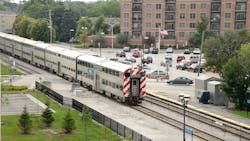High-tech air purification system to be installed on Metra railcars
Metra is significantly upgrading the ventilation system on its railcars with a new three-stage filtration and purification process, as part of its efforts to create safety and build rider confidence.
The new system uses ultraviolet light, electrical fields and stronger filters to create the safest possible environment for its customers. Metra says it is among the first agencies to adopt such a comprehensive system for its railcars.
The new system is expected to remove and eliminate 99 percent of all airborne particulates, bacteria and viruses, including the virus that causes COVID-19. Metra already refreshes the air every four minutes and uses hospital-grade MERV 13 filters on its train cars; the new system will be the equivalent to or better than MERV 17 or HEPA standards.
“The air in our trains is already proven safe and healthy, but this new cutting-edge system sets the highest industry standard for quality,” said Metra CEO/Executive Director Jim Derwinski. “Combined with all the other steps we have taken to clean, disinfect and sanitize our system, and to promote healthy behavior by riders and workers, this is just one more reason our customers can ‘Commute with Confidence.’”
The Metra Board of Directors approved a contract with Transitair Systems LLC, of Hornell, N.Y., to provide the new air filtration and purification system on nearly 700 railcars for $6.6 million. The contract will cover all cars that are not due to be replaced when new cars (with a similar or better system) enter the fleet. The system, designed to fit in the same space as the existing HVAC system, will be tested on 50 cars before options for additional units are approved.
Under the new system, air will be cleaned in a three-step process.
The first step relies on an electrical attraction between airborne particles and the interior surfaces of a filter. Air will pass through one filter, and then through a unit that charges particles in the air, which are attracted to oppositely charged surfaces as the air passes through a second filter.
The second step uses ultraviolet light to kill or inactivate bacteria, mold and viruses.
In the final step, air passes through a unit with electrically charged ions and electrons, which react with airborne particles to remove or inactivate pollutants and viruses.
